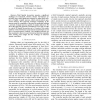Free Online Productivity Tools
i2Speak
i2Symbol
i2OCR
iTex2Img
iWeb2Print
iWeb2Shot
i2Type
iPdf2Split
iPdf2Merge
i2Bopomofo
i2Arabic
i2Style
i2Image
i2PDF
iLatex2Rtf
Sci2ools
94
Voted
IROS
2009
IEEE
2009
IEEE
Complex networks of simple neurons for bipedal locomotion
— Fluid bipedal locomotion remains a significant challenge for humanoid robotics. Recent bio-inspired approaches have made significant progress by using small numbers of tightly coupled neurons, called central pattern generators (CPGs). Our approach exchanges complexity of the neuron model for complexity of the network, gradually building a network of simple neurons capable of complex behaviors. We show this approach generates controllers de novo that are able to control 3D bipedal locomotion up to 10 meters. This results holds for robots with human-proportionate morphologies across 95% of normal human variation. The resulting networks are then examined to discover neural structures that arise unusually often, lending some insight into the workings of otherwise opaque controllers.
Approach Exchanges Complexity | Approach Generates Controllers | Bipedal Locomotion | IROS 2009 | Robotics |
Related Content
| Added | 24 May 2010 |
| Updated | 24 May 2010 |
| Type | Conference |
| Year | 2009 |
| Where | IROS |
| Authors | Brian F. Allen, Petros Faloutsos |
Comments (0)

